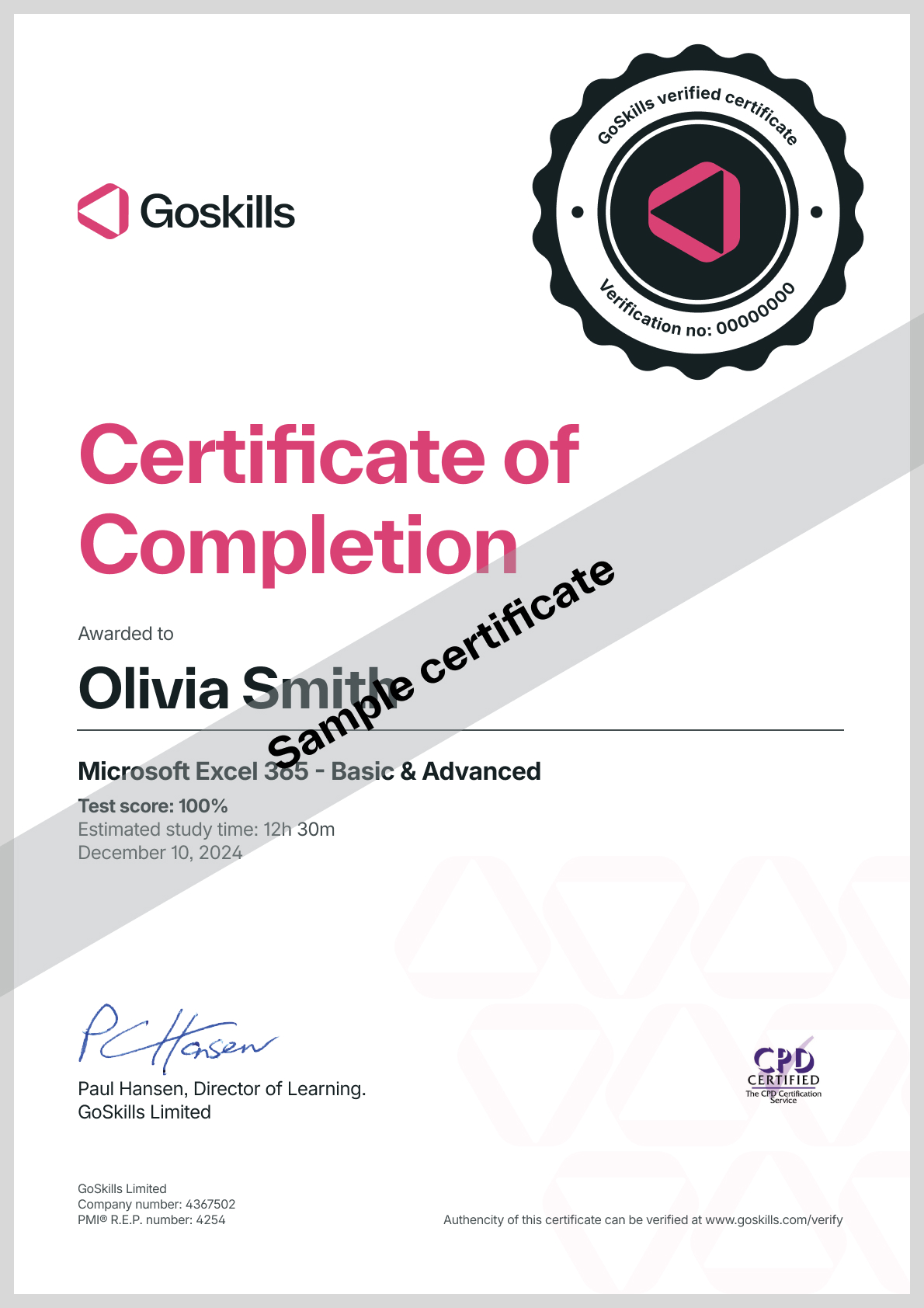Advanced Microsoft Office Training | Learn Excel Online
Microsoft Excel 2019 - Advanced
Skills you’ll gain
Have some experience with Excel and want to improve your skills, or taken our Basic Excel course? This online course will help you learn intermediate and advanced Excel techniques. Supports Excel for Windows 2010, 2013, 2016, 2019, Microsoft 365. Also available: Excel Advanced for Mac.
In 28 engaging lessons you will learn how to find a value with VLOOKUP, create and format Pivot Tables, record basic Macros and more.
Whether you use Excel for work or study, these tutorials will help you on your journey to becoming an Excel Ninja! Learn more about how a GoSkills Excel certification can boost your career.
The course is Excel 2010, 2013, 2016, 2019 and Microsoft 365 compliant (previously known as Office 365). Videos are recorded in Microsoft Excel 2019, 2016 and 2013 for PC, and where the user interface is significantly different, Excel 2010 videos are provided too.
If you haven’t used Excel before, try our Basic course, or the beginner to advanced lessons in our combined Basic and Advanced course. If you'd like to learn more advanced techniques, check out our Macros and VBA course.
Want to be a more efficient Excel user? Start learning 200 of the best Excel shortcuts for PC and Mac.
Once enrolled, our friendly support team and tutors are here to help with any course related inquiries.
Syllabus
Download syllabus-
1
Formula Auditing Learn to work with formula auditing tools including tracing precedent and dependent cells and formula evaluation. 5m
-
2
Temporal Functions Learn to work with the EOMONTH and EDATE functions that easily shift dates from one month or year to another. 4m
-
3
VLOOKUP with Approximate Match Learn to use VLOOKUP to find an approximate match and return it or the corresponding value from another column. 4m
-
4
VLOOKUP with Exact Match Learn to use VLOOKUP to find an exact match and return it or the corresponding value from another column. 5m
-
5
Other Lookup Methods Learn to work with INDEX, MATCH and HLOOKUP, as alternatives to the VLOOKUP function. 5m
-
6
Introduction to XLOOKUP An introduction to the new XLOOKUP function in Microsoft 365. Bye, bye VLOOKUP, HLOOKUP and INDEX/MATCH! Note: this lesson uses Excel Tables, which are introduced in the next section. 7m
-
1
Naming Ranges Learn about creating named ranges, and the benefits of doing so. 4m
-
2
Excel Tables Learn about creating Excel tables, and their advantages. 5m
-
3
Recording Macros Learn to record basic Excel macros to automate your actions (instead of doing them manually). 5m
-
1
Creating PivotTables Learn to create and modify basic PivotTables (for quickly summarizing and highlighting data). 4m
-
2
Formatting PivotTables Learn to control formatting and other options in PivotTables. 5m
-
3
Calculated Fields in PivotTables Learn to create and modify basic calculated fields for PivotTables. 4m
-
4
What-If Analysis Learn to perform what-if analysis in Excel using the Scenario Manager and Goal-Seek. 5m
-
1
Unpivoting Data If you work with PivotTables a lot, you know that they put information out the way users want to read it, but you can't use it to drive another PivotTable. So what if there was an easy way to unpivot the data? There is, and it's called Power Query! 5m
-
2
Importing Data from a Text File Importing data from a text file into an Excel table using Power Query. 5m
-
3
Appending Tables Appending tables is the process of stacking them vertically to create long tables that can be used to feed business intelligence solutions and PivotTables. 5m
-
1
Outlining Learn about adding and working with Excel’s outlining tools to quickly hide irrelevant sections of your worksheet. 5m
-
2
Custom Number Formats Learn to build your own custom number formats to display dates, values and variances how you want to see them. 6m
-
3
Conditional Formats with Built-In Rules Learn to create top/bottom and highlight cell rules, as well as to apply icon sets and data bars. 5m
-
4
Conditional Formats with Custom Rules Learn to create custom conditional formatting rules based on formulas. 5m
-
5
Building Combination Line and Area Charts When you want to graph 3 line series, but only want 2 in focus most of the time. 5m
-
1
Data Validation Learn how to use Data Validation to ensure that users enter valid data in input cells. 5m
-
2
Data Validation Lists Use to restrict users ability to enter invalid data in cells by providing them with a drop down list of valid options. 5m
-
3
Styles Learn how to apply built-in number styles and create your own custom styles packages. 4m
-
1
Introduction to Dynamic Arrays An introduction to the new Dynamic Arrays capability added to Microsoft 365. 7m
-
2
FILTER-ing Dynamic Arrays with a Single Condition Using FILTER() to restrict the results of a Dynamic Array based on a single condition 9m
-
3
FILTER-ing Dynamic Arrays with Multiple Conditions Combining multiple conditions in a single FILTER() to restrict the results of a Dynamic Array 6m
-
4
Wildcard XLOOKUPs and Dynamic Arrays Advanced options for XLOOKUP including using wildcard matches and returing Dynamic Arrays as an output 8m
-
1
Custom Views Learn how to create and manage Custom Views in a worksheet. 3m
-
2
Page Setup Options Learn about page setup options, fitting print jobs on a page, headers and footers, and other ways to customize print jobs. 4m
-
3
Security Considerations Learn about the setup and weaknesses of Excel’s security systems. 4m
Certificate
Certificate of Completion
Awarded upon successful completion of the course.

Instructor
Ken Puls
Ken Puls is a globally recognized authority in Microsoft Excel, Power Query, and Power BI, with over two decades of hands-on experience in accounting, IT, and business intelligence systems. His career began in public practice accounting and industry, where he served as both Controller and IT Director, leading numerous system implementations and designing custom business intelligence solutions from the ground up.
Ken’s deep technical expertise is matched by a passion for teaching and community engagement. He has authored several acclaimed books, including RibbonX – Customizing the Office 2007 Ribbon, Power Query Recipes, and Master Your Data with Power Query in Excel and Power BI. His writing reflects a clear, practical approach to solving real-world data challenges.

Ken Puls
Excel MVP
Accreditations
Link to awardsHow GoSkills helped Chris
I got the promotion largely because of the skills I could develop, thanks to the GoSkills courses I took. I set aside at least 30 minutes daily to invest in myself and my professional growth. Seeing how much this has helped me become a more efficient employee is a big motivation.


